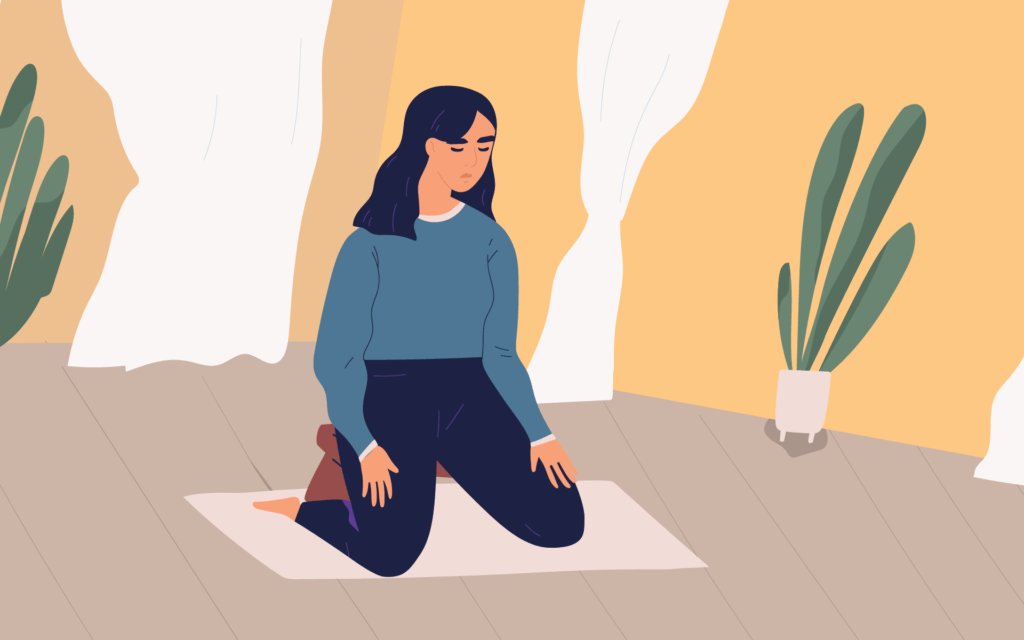When it comes to how you sit in meditation, certain postures are going to support your ability to focus, be relaxed, and enhance your awareness of the moment. Others can sometimes lead to distraction and pain. Especially in meditation for beginners, it’s important to explore different postures and find what works best for you. The right posture for one person is the wrong posture for somebody else. What might create calm and ease in one person’s practice might create discomfort for another person.
Here are five postures for you to try so that you can focus on your practice and get more out of your meditation. You can watch me teach all of these different ways to sit in this video.
5 Meditation Postures for Beginners
1. Classic Sitting
In classic sitting we want to create an upright posture. We want to keep the spine straight to facilitate easy breathing, and we want ease in our bodies so that we can focus on our breath, our body, or sounds around us.
For this posture, I like to use two pieces of equipment. I have a zafu, which is a cushion. There are different kinds of these—some stuffed with cotton, some stuffed with buckwheat. The cotton ones tend to get smushed down over time, and so the buckwheat ones will stick with you a little bit longer because they’re malleable. I also have a zabuton, which is a larger cushion. I use this under my zafu because I find it more comfortable for my ankles and my knees when they’re placed on it rather than on the hard ground. You can also use cushions from your couch or bed.

The point of exploring different meditation postures is to be comfortable. Whether you’re new to practice and are looking for postures friendly to meditation for beginners, or you’re looking for modifications due to pain and mobility restrictions, there are many good options to choose from.
We want the knees lower than the hips, optimally. If you need your knees to be placed higher than your hips, you may want to get a prop of some kind to hold yourself up. We don’t want to expend the energy needed to hold our knees up, because the goal is to be comfortable and at ease.
2. Classic Sitting With Modifications
To make modifications to classic sitting, you can turn the zafu or cushion on its side to sit a little higher up off the ground. Our knees are still beneath our hips in this posture and our spine is still upright, yet natural. Our neck is straight and our hands can rest on our thighs.

3. Sitting Bench
Using a sitting bench is another way to get comfortable for seated meditation. You can sit your bottom on the bench, with your calves or ankles placed under the bench. The bench can help to support your body and allow for a straight spine. If you need more support, you can grab a pillow and place it on the bench under your bottom. Try a 5, 10, 20, or 30-minute practice and see how the posture feels. Ask yourself: Does this feel good to my body?

4. Chair
If you experience chronic knee pain, you may want to meditate seated in a chair. Sit normally in a chair, keep your legs bent and straight without straining your knees in any way, and make sure your feet can touch the ground. Place your hands in your lap and keep your spine straight and your body relaxed. Your muscles aren’t working or stiffening to hold your body up and you can even lean against the back of your chair.

5. Legs on Chair
If you experience chronic lower back pain, you may want to explore meditation postures that allow you to lie down. Lie down on the floor or on a cushion and if you still feel like you need support, try placing your calves on the seat of a chair. Allow your arms just to fall to your sides. You can also put a pillow under your head if you want to. If you find yourself getting sleepy in any way while doing this, then gently open your eyes. You’re fully supported in your legs. Your lower back is fully supported, and none of your muscles in your upper back are working to hold you up.

6 Tips for Basic Seated Meditation Posture
- Eyes gaze slightly downward, 4 to 6 feet in front of you, or eyes closed.
- Chin slightly tucked to keep your cervical spine aligned.
- Spine follows natural curvature—upright, yet natural.
- Sitting bones are centered and stable—not perched too far forward or spread too far back.
- Arms parallel to the torso, palms fall naturally on the thighs.
- Knees below hips, with legs loosely crossed.
read more
Meditation for Anxiety
Explore how mindfulness and meditation can help soften feelings of anxiousness, reduce stress, and calm a panic attack.
Read More
Interested in Meditation? Here Are the Basics
Meditation is a core mindfulness practice that you can customize to meet you where you are, bring your attention to the present moment, and engage in more compassion and connection. Here’s what you need to know to get started.
Read More
Your Guide to Finding the Best Mindfulness Teacher
The next step toward deepening your mindfulness practice may be finding a teacher that can offer you new insights. In our easy-to-use guide, we’ve outlined what to look for in a mindfulness teacher, and how to find the right one for you.
Read More









